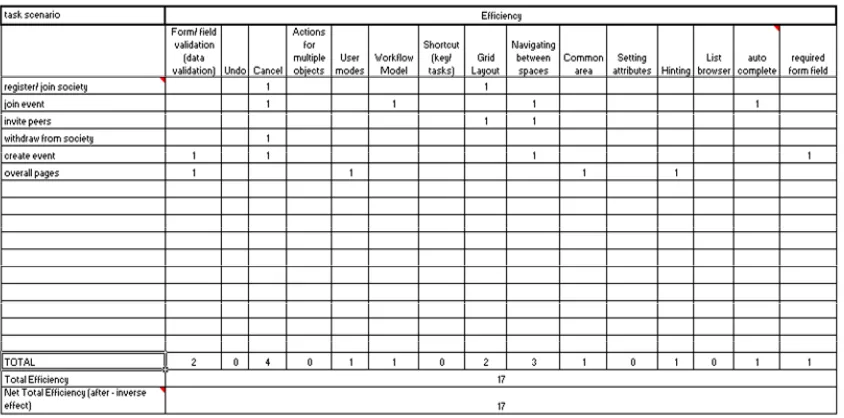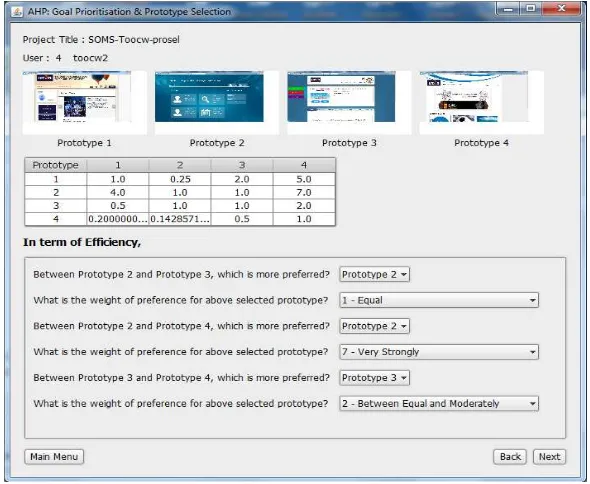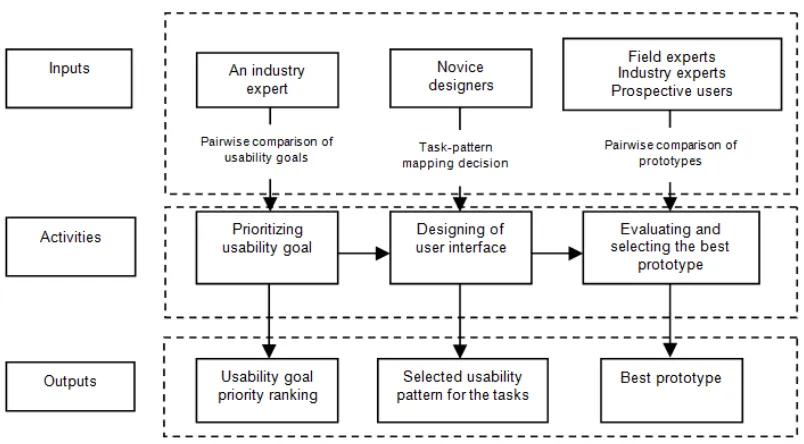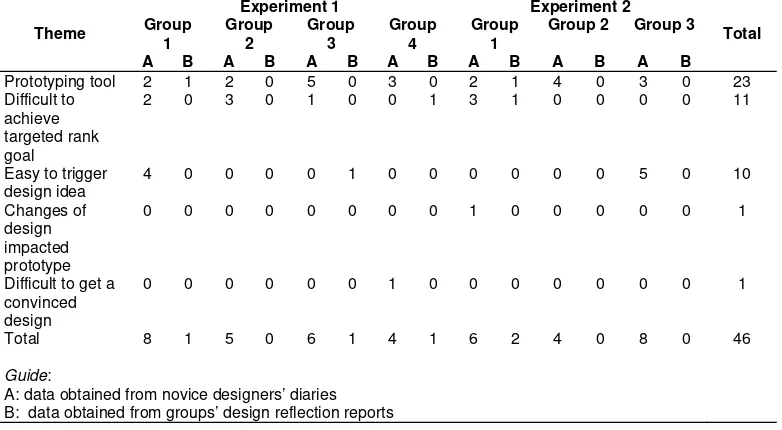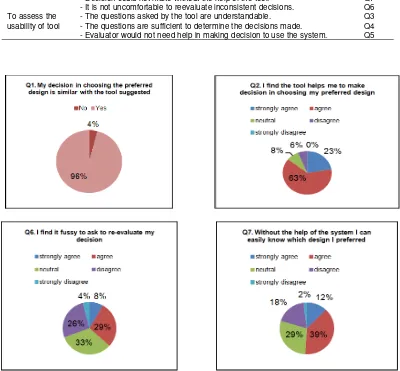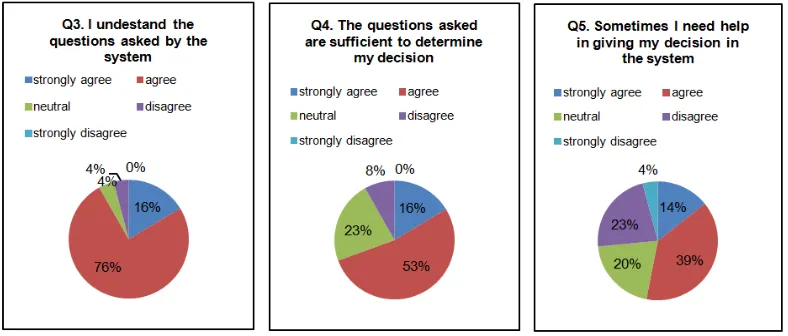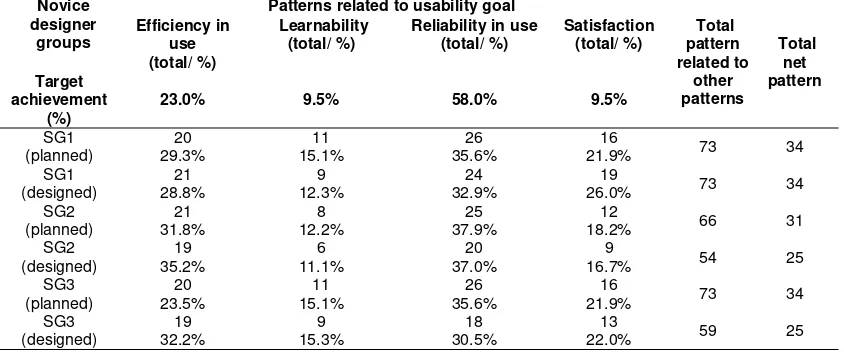DOI: 10.12928/TELKOMNIKA.v14i1.3116 715
A Systematic Design towards Usability for Novice
Designers
Hoo Meei Hao*1, Azizah Jaafar2 1
Lee Kong Chian Faculty of Engineering and Science, Universiti Tunku Abdul Rahman, Malaysia 2Institute of Visual Informatics, Universiti Kebangsaan Malaysia, Malaysia
*Corresponding author, e-mail: hoomh@utar.edu.my1, azizahj@ukm.edu.my2
Abstract
Dependence on intuitive and experiences would add more complexity in the design process. Novice designers would follow the design of any existing systems without direction. This paper proposed a systematic design approach that provides guidance for novice designers in achieving the targeted usability goal using patterns, and evaluating the prototypes in achieving the determined usability goals. The proposed approach involved the cooperation of experts in providing direction to the novice designers in achieving usability goal in the system design. A collective decision both from users and experts would be gather to give a clear decision of a chosen prototype. Two experiments that followed the proposed approach were conducted with 7 groups or 33 undergraduate students. Ten industry experts, 10 field experts and 29 prospective users were involved in evaluating the appropriate use of the tool to assist them in making decision during comparative prototype evaluation. The result from both experiments concluded the systematic approach could help the novice designers to emphasize usability along the design process. It was observed that the achievement of important goals in their designed prototype could be easily done if pattern selection was provided to the novice designers. The designed tool to assist novice designers has high reliability and high acceptance level of appropriate of use in making decision for the preferred prototype.
Keywords: usability goal; usability pattern; design decision;comparative prototype evaluation; analytical hierarchical process
Copyright © 2016 Universitas Ahmad Dahlan. All rights reserved.
1. Introduction
Experienced designers rely on the available design guidelines, past design experiences, templates and problem-solution sets from previous experiences. This concurs to the study claimed that practitioners were depended on their intuition and experiences gained [1]. Thus, novice designers would find difficulties in designing intuitively if experience and knowledge are not sufficiently gained. Subsequently, further research works have been explored on how knowledge and experience were used among experienced and novice designers such as in [2, 3] and [4]. Reference [4] suggested that design strategies, knowledge, and information should be included in developing support methods for novice designers as a guide to them.
Previous works in [5, 6] explored the use of guidelines and patterns as an aid to teach design. The result from [5] has shown the use of design patterns displayed a greater impact on the novice designer’s performance than guidelines. We considered all design related knowledge and information such as design decision and design pattern in the proposed method that leading to the development of the tool.
proposed task-mapping template drives the novice designer to achieve the targeted usability goals. The design and development of the tool were to capture users’ and experts’ decision in selecting the best prototype, thereafter helping the novice designer to know the best choice of prototype based on the targeted usability goals.
This paper is structured as follows. First, the paper gives an overview of the proposed method and tool used in this study. This is followed by a description of the experiment and data collection methods. In the next section, findings are presented and discussed. Finally, we provide the conclusion and future work.
2. Research Method
In the beginning, we acquired the priority rank of the usability goal for the system design from experts. The result was served as a direction in the system design for the novice designers which assist them to determine the selection of patterns on the selected design tasks.
Prior to designing the interface, novice designers were conducting user and task analysis with the prospective users, in relating to the designed system. Based on the users analysis result, they chose the important task that the prospective users required. The designed tasks were used in their focus in applying usability patterns. This was followed by designing an interactive prototype using a prototype tool. In the evaluation stage, they were required to arrange the potential users to provide feedbacks on their design and selection of prototype from the comparative prototype evaluation. The decisions of usability goal prioritization and prototype selection were assisted by the proposed tool.
The design of the proposed tool was divided into four main modules. There were namely: usability goal prioritization, prototype selection to aggregate all the consistent decisions made by users and experts after walk-through all prototypes, the calculation to check for consistency decision and determine the most inconsistency decision in the matrix for re-evaluation, and administration module to setup project description and evaluators’ profile of users and experts. The system would help the designer to efficiently know the ranking of the usability goal and determine the prototype selection. The 3 main activities in the proposed approach include of prioritization usability goal, designing of user interface following pre-determined usability goal, and evaluating and selecting the best prototype.
Industry experts from software development and field experts related to interaction design, usability, or interface design were invited to prioritize the four common usability goals based on a system design. The selection of the chosen usability goal for prioritization was adopted from the analysis made by [11] that showed learnability, efficiency in use, reliability in use and subjective satisfaction were the most commonly cited. The method of prioritization and selecting prototype were adapted from [12, 13] called Analytical Hierarchical Process (AHP), a multi-criteria analysis approach. Further discussion on the methodology in the prioritization and prototype selection can be found in [14]. The result of the prioritization was served as a goal for novice designers to target.
Following approaches in design for usability discussed in [15], we required the students or novice designers to follow user-centered design approach. The design assignment was started to understand users and tasks in the system design. The novice designers gather user information and performed the task analysis of the system. During the development of design, the novice designers started with sketches or wireframe prototype and improved their design as they went on designing the prototypes to a higher fidelity. The novice designer were provided a list of usability patterns supported with some usable design solutions. Based on the given template, the novice designers followed the selected patterns that matched the targeted usability goal set by the expert in the previous activity, for all identified important tasks. The usability patterns served as a reference and guided them to achieve the usability goal. The usability patterns were adopted from 19 user-perspective patterns of interaction patterns from [6], 21 architectural usability patterns by [16], and 10 functional usability pattern from [17], are categorized into the 4 common usability goal or usability attributes . Figure 1 shows a partial template screen of a task-pattern mapping for efficiency goal. The task-pattern mapping is to drive their design solution to meet the targeted usability goals.
usability goals. The percentage for each usability goal related pattern that adopted in the designed tasks is defined as:
∗ (1)
Where UGP is the number of patterns related to a usability goal, IUGP is the number of patterns that has inverse effect with the related usability goal, and P is total pattern applied in the designed tasks for the system.
Figure 1. An example of a partial screen of the task-pattern mapping for efficiency
This was served as an approach for the novice designers to plan their design. Table 1 shows an example of a result of the usability goal fulfillment determined by the novice designers in a team. Novice designers would refer to the percentage weighting given by the experts via prioritizating 4 main usability goals, and the ranking of usability goal that determined the level of importance. Designers can start their work with these goals in mind and based on the decided usability pattern in all designed tasks.
Table 1. Summary of usability goal fulfillment in design planning
Usability Goal Efficiency Learnability ReliabilitySatisfaction Total patterns
Pattern 27 11 26 16
Pattern affected (negative effect) 7 0 0 0 7
Net total pattern (positive effect) 20 11 26 16 73
% achieved 27.4 15.1 35.6 21.9 100
Targeted (%) 23 9.5 58 9.5 100
The majority of the users were not familiar putting their preferences scale in the AHP’s matrix. We provided a guided dialogue for the evaluators to make their decision in a designed tool. Figure 2 shows a guided dialogue of pair-wise comparison scale for 4 prototypes in efficiency in use using the designed tool. Besides calculating for consistency ratio, the system was also checked for inconsistency ratio, which was more than 0.10. Inconsistency ratio found in a decision matrix will allow the evaluator to re-evaluate their decisions made. This is based on the discussion on the Saaty’s theory on satisfying consistency matrix in [12]. We adopted the theory and identified three locations on the matrix to evaluate based on the highest differences value between the user preferences scale and the satisfactory value from the consistent pair-wise comparison matrix. After completing receiving all the evaluators’ decision, the consistent evaluators’ decision result will be aggregated and the chosen prototype will be determined based on the highest total weighted evaluation. This is achieved by multiplying the factor weight for each usability goal with factor evaluation for all prototype designs.
Figure 2. A guided dialogue to assist an expert made decision on the evaluated prototype in a designed tool
3. Research Method
In understanding the proposed approach, we were conducting 2 experiments with private institution students who were taking the subject of designing user interface. They were students in Year 2 software engineering programme. Figure 3 gives a combination of an overall flow of the proposed approach to driving novice designers design towards usability, in both experiment designs.
Figure 3. Overall flow of the proposed approach for user interface design
Table 2. Summary of data collection methods
Participants Method/ analysis Purpose
Novice designers
Content analysis: Group design reflection Individual’s design diaries
To evaluate the appropriateness of the proposed approach in designing the prototypes.
Prospective users and experts (field and industry experts)
Quantitative and qualitative survey
To evaluate the appropriateness of the proposed tool assisting their decisions.
Prototypes designed by novices
Content analysis: Review the application of patterns in the prototypes
To evaluate the pattern usage in fulfilling the goal.
Two experiments were conducted in designing the user interface of different systems in different semester. In the first experiment, there were 4 groups, in which 6 members in each group, involved in the user interface design for a student community system for a university. Whereas in experiment 2, a total of 10 novice designers were grouped in 3, involved in the design of user interface for managing stationery. The difference in the number of participants involved in the experiments depends on the number of students in the second year software engineering taking the designing user interface unit in the semester. Both experiments follow the same approach and tool as described in section 2, except the decision for selecting appropriate patterns. Novice designers in experiment 1 were freely decided the appropriate patterns for the identified designed tasks and matched the targeted usability goal set from the result of usability goal prioritization. While novice designers in experiment 2 followed the pre-determined patterns that deemed appropriate for the designed tasks. The patterns used in experiment 2 were decided by the researcher.
4. Results and Discussion
Data of seven groups of novice designers from two experiments were collected. Ten industry experts, 10 field experts, and 29 prospective users from experiment 1 or surrogate users from experiment 2 were involved in evaluating the tool. Evaluation of the appropriateness of the proposed method and tool are discussed in the following section.
4.1. Appropriateness of the Proposed Approach in Designing the Prototypes
designers in the written logs and reports, was summarized in Table 3. Based on the result, the substantial problems occur were difficult in using prototyping tool and difficult in achieving targeted rank goal using the usability goal fulfillment. The difficulty in using prototyping tool occurred because novices took some time to familiar with the tool to complete their prototypes. However the problems were reducing after 2 hours hands-on and demonstration was conducted in the experiment 2 in order to familiarize the functions of the tool provided. Similarly, the problem of achieving targeted rank goal was reducing tremendously after the decision of selecting patterns was given to novice designers as a guide in the experiment 2 compare to the same problem was reported more than 30% in experiment 1. No aid was given to novice designers in experiment 1 to determine the patterns for each designed tasks. They have to decide themselves the usability pattern that would appropriate for the designed tasks. These had showed that guide to select patterns used for the designed task was needed on top of the usability goal fulfillment. However, design following usability patterns had given the novice designers an approach to trigger ideas in their design. This had been reported by 3 groups in both experiments.
Table 3. Number of themes discussed in the reports and logs for experiment 1 and experiment 2
Theme
Experiment 1 Experiment 2
Total
A: data obtained from novice designers’ diaries B: data obtained from groups’ design reflection reports
4.2. Appropriateness of the Proposed Tool Assists Evaluators’ Making Decisions
Table 4. Questionnaire Structure
Purpose of questions
Hypothesis Questions
To assess the appropriate use
- The result generated by the designed tool is matched with the result of an evaluator’s decision.
Q1
- The designed tool assists evaluators to make decision in the preferred prototype.
Q2
- Decision could not make without the help of the tool. Q7
- It is not uncomfortable to reevaluate inconsistent decisions. Q6
To assess the usability of tool
- The questions asked by the tool are understandable. Q3
- The questions are sufficient to determine the decisions made. Q4
- Evaluator would not need help in making decision to use the system. Q5
Figure 4. Survey result on appropriate use of the tool
aggregated to give a reliable absolute result in selecting the prototype during comparative evaluation.
The designed tool also has high usability in terms of understandable of the questions asked, with 92% of the total respondents, and sufficient of the questions (69% of the total respondents). Nevertheless, about 53% of the total respondents need help in using the tool. We observed that 2 experts were having difficulties to reconsider their inconsistent decisions. They informed that they did not know what needs to be changed to achieve a consistent result. This explained the high frequency of help was needed in using the tool. However, the tool provides the flexibility to change the evaluators’ decisions according to the questions asked or to maintain their inconsistent decisions. Detailed assistance to help to achieve consistent decisions does not represent the decision from an evaluator.
Figure 5. Survey result on the usability of the tool
4.3. Evaluation of the Usage of Usability Pattern
Figure 6 summarizes the usability patterns use in the design of a prototype in each novice designer’s group in achieving the targeted priority of usability goal. All groups could not meet the targeted priority of the usability goal. All 4 groups have more patterns related to satisfaction than learnability. Among all groups, only one group (group 1) has achieved the highest priority in patterns relate to efficiency in use. Whilst other 3 groups focused on patterns related to reliability in use more than other goals. This result occurred as novice designers independently chose the patterns relate to their designed tasks. Improvements were made in the methodology of choosing usability patterns were conducted and evaluated in experiment 2.
Selections of usability patterns related to the designed tasks were reviewed to determine its relevancy as well as in achieving the targeted usability goal. We have put emphasizing on the use of pattern for the designed tasks that would be evaluated in usability testing and comparative prototype evaluation. Table 5 shows the summarization of the planned usability pattern and the implementation of the targeted priority of usability goal in experiment 2.
Result in experiment 2 found that not all groups can completely meet each targeted percentage of pattern in their designed prototype as planned. Novice designers were new and require time to master their skills in the construction of designed prototype using the tool. Two groups, which were group 1 and 2, could place the highest priority target of reliability in use in their designed prototype with the achievement of 24 patterns and 20 patterns respectively. Whilst group 3 has 1 pattern difference between the goals of reliability in use and efficiency in use. The main finding from the improvement of the usage of usability pattern in experiment 2 was the achievement of important goals in their designed prototype could be easily done if pattern selection was provided to the novice designers rather than independently decided by them.
Table 5. Total and percentage of usability pattern usage in prototype design for experiment 2
Novice designer
groups
Patterns related to usability goal
Total
Result from the analysis of the designed prototypes and comparison with the planned pattern found that some patterns were not designed in a prototype of a group but were designed in another prototype of another group. Inequality of the implementation of usability pattern in the designed prototype with the plan would derive some reasons. One of them was novice designers may not always refer to the patterns in the plan while implementing the prototype. Other reasons may include novice designers could not dominate the skill in using the tool to develop the prototype following the planned patterns. Novice designers in group 1 were able to realize the importance of trade-off usability goal following the targeted priority in usability goal. Some patterns that deemed relevant to the designed tasks were related to efficiency in use, reliability in use, and satisfaction. These patterns were added in their designed prototype without affecting the position of highest priority in usability goal.
5. Conclusion
Achieving balance of usability goal is important in the design process towards usability. Furthermore, novice designers would not follow blindly the design from any existing systems if a method of achieving usability along design process is imposed. Therefore, the systematic approach to design based on usability patterns discussed in this paper become the design rationale and guide towards achieving the targeted usability goals. AHP technique was customized in the design process to assist in collecting data prioritization of usability goals and prototypes.
novice designers how trade-off of usability pattern is made in fulfilling the targeted priority of usability goals. However, guidance to select appropriate pattern needs to come from industry or field expert to ensure its suitability and relevancy of chosen patterns with the designed tasks and achievement of usability goal. In deciding the best prototype in fulfilling the usability goals during the comparative evaluation process, it had shown a collective decision both from users and experts. This could give a clear decision of a particular prototype was chosen that supported with the weight of preference of each usability goals.
The result from both experiments concluded the proposed systematic approach using usability patterns to achieve usability goals could help the novice designers to emphasize usability in designing. Novice designers found that the usability patterns could easily trigger design ideas. The designed tool has high reliability due to high percentage of similarity of decision priority with the individual evaluators’ decision. It also has high acceptance level of appropriate of use in decision-making for the preferred prototype and high acceptance level for usability in terms of understandable and sufficient questions. Supports from the tool to collect decision data and to guide evaluators to reassess their inconsistency decision to achieve the validity result of the selection of prototype were also included although evaluators may find the difficulty in achieving consistency in their decisions. The systematic design provides guidance for novice designers in prioritizing the usability goal, achieving the targeted usability goal using patterns, and evaluating the prototypes in achieving the usability goals. More studies will be required to determine if the approach could help in delivering good quality of prototype that has less number of iteration and less number of usability problems found.
References
[1] Rogers Y. NEW THEORETICAL APPROACHES FOR HCI. Annual Review of Information Science and Technology. 2004; 38: 87-143.
[2] Waldron MB, Jelinek W, Owen D, Waldron KJ. A study of visual recall differences between experts and naive designers. International Conference of Engineering Design (ICED 87). 1987.
[3] Kavalki M, Gero JS. Strategic Knowledge Differences between an Expert and a Novice Designer. Human Behaviour in Design Individuals, Teams, Tools. Berlin, Springer. 2003: 42-52.
[4] Ahmed S, Wallace KM. Understanding the differences between how novice and experienced designers approach design tasks. Research in Engineering Design. 2003; 14: 1-11.
[5] Koukouletsos K, Khazaei B, Dearden A, Ozcan M. Teaching Usability Principles with Patterns and Guidelines. In: Kotzé P, Wong W, Jorge J, Dix A, Silva P. Editors. Creativity and HCI: From Experience to Design in Education. Springer US; 2009: 159-174.
[6] Welie M Van, Veer GC Van Der, Eliëns A. Patterns as Tools for User Interface Design. Tools for Working with Guidelines. 2001: 313-324.
[7] Hao HM, Jaafar A. Novice Assistance Tool and Methodology: Design Decision and Task-Pattern Mapping. Proceeding of the Electrical Engineering Computer Science and Informatics. 2015; 2. [8] Ci T, Liu X. The Study of Selection of Coal Fired Supplier in Thermal Power Enterprise Based on the
Extension Analysis Method. TELKOMNIKA Indonesian Journal of Electrical Engineering. 2013; 11: 3874-3885.
[9] Sheng W, Zhang L, Tang W, Wang J, Fang H. Optimal MultiDistributed Generators Planning Under Uncertainty using AHP and GA. TELKOMNIKA Indonesian Journal of Electrical Engineering. 2014; 12: 2582-2591.
[10] Dinglei W, Jianyong L, Wensheng X. The Methods of Factor Weight’s Determine in the Process of Cluster. TELKOMNIKA Indonesian Journal of Electrical Engineering. 2012; 10: 1137-1141.
[11] Folmer E, Gurp J Van, Bosch J. A framework for capturing the relationship between usability and software architecture. Software Process. 2003.
[12] Saaty TL. The Analytic Hierarchy Process: Planning, Priority Setting, Resource Allocation. McGraw Hill International. 1980.
[13] Saaty TL. Decision making with the analytic hierarchy process. International Journal of Services Sciences. 2008; 1: 83.
[14] Hao HM, Jaafar A. Goal prioritization and preliminary usability evaluation: An approach to assist novice designer. Journal of Theoretical and Applied Information Technology. 2014; 67: 690-700. [15] Keinonen T. One-dimensional usability: influence of usability on consumer’s product preference.
University of Art and Design; 1998.
[16] Folmer E, Bosch J. Usability patterns in software architecture. Proceedings of the 10th International Conference on. 2003.
